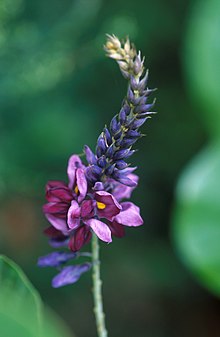Fabaceae
| Fabaceae Temporal range: Palaeocene–Recent |
|
|---|---|
 |
|
| Kudzu (Pueraria lobata) | |
| Scientific classification | |
| Kingdom: | Plantae |
| (unranked): | Angiosperms |
| (unranked): | Eudicots |
| (unranked): | Rosids |
| Order: | Fabales |
| Family: |
Fabaceae Lindl. (Leguminosae Jussieu, nom. cons.). |
| Type genus | |
|
Faba (now included in Vicia) Mill. |
|
| Subfamilies | |
|
|
| Diversity | |
| 730 genera and 19,400 species | |
 |
|
| Fabaceae distribution map. Legumes are found in four major biomes: rain forest, temperate, grass, and succulent. | |
| Synonyms | |
The Fabaceae, Leguminosae or Papilionaceae, commonly known as the legume, pea, or bean family, are a large and economically important family of flowering plants. It includes trees, shrubs, and perennial or annual herbaceous plants, which are easily recognized by their fruit (legume) and their compound, stipulated leaves. The family is widely distributed, and is the third-largest land plant family in terms of number of species, behind only the Orchidaceae and Asteraceae, with about 751 genera and some 19,000 known species . The five largest of the genera are Astragalus (over 3,000 species), Acacia (over 1000 species), Indigofera (around 700 species), Crotalaria (around 700 species) and Mimosa (around 500 species), which constitute about a quarter of all legume species. The ca. 19,000 known legume species amount to about 7% of flowering plant species. Fabaceae is the most common family found in tropical rainforests and in dry forests in the Americas and Africa.
Recent molecular and morphological evidence supports the fact that the Fabaceae is a single monophyletic family. This point of view has been supported not only by the degree of interrelation shown by different groups within the family compared with that found among the Leguminosae and their closest relations, but also by all the recent phylogenetic studies based on DNA sequences. These studies confirm that the Fabaceae are a monophyletic group that is closely related to the Polygalaceae, Surianaceae and Quillajaceae families and that they belong to the order Fabales.
...
Wikipedia
